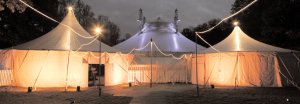
Capital development projects cause massive upheaval for arts organisations and their audiences. Colin Blumenau describes the lessons that venues can learn in a period of closure and how to plan for reopening.
If youre lucky, Realisation (the capital is intentional, its that important) dawns before its too late. A lengthy building project that closes a theatre means that everything about which you are secure and knowledgeable flies out of the window. Suddenly you are thrown into a maelstrom of activity and terminology about which you know next to nothing. You focus all your energy on the project in hand. The questions mount: What should my relationship with a quantity surveyor be?, What is CDM?, How are we going to raise the £5m we need to complete the project? The list of questions is inordinately long and somewhere, almost obscured by all the other concerns, comes: What are we going to do while were closed? It is a question that must be addressed as early in the process as possible. There are many, many issues to weigh up and because you, your staff and probably your board are working in very unfamiliar territory you are flying blind.
When we committed to restoring the Grade I listed Regency Theatre Royal in Bury St Edmunds, we also properly considered our audiences, our fantastically loyal staff and our responsibilities under a variety of funding agreements and, after a period of mature reflection and discussion, committed to continuing to operate. So, with all guns blazing we launched into the unknown. We programmed all kinds of work in unfamiliar spaces churches, village halls, community centres, meeting rooms and, for our pantomime at Christmas-time, a Big Top tent the panto being a real institution and, as such, invaluable.
We committed to keeping our Education and Community programme going at full whack. We produced a business-as-near-usual-as-possible-under-the-circumstances brochure, maintained a virtually full staff and planned to use an unexpected financial windfall from our VAT reclaim to finance the whole thing over the period of two years closure. We felt quite good about it too. Here we were bucking the trend, being plucky in the face of adversity. We felt we had done well, having constructed our business plan entitled Operating through Closure.
Lessons learnt
All that was a year ago. With 12 months gone and 12 months still in prospect, it is marginally easier to see the wood for the trees. In general terms, it is easy to say that it has proved much more difficult and much more expensive than we had expected. The first three months of closure provided many salutary lessons.
In the first instance, the programme we offered failed to set the public alight. They disliked most of the alternative spaces, they were unprepared to travel, they missed the core element of our middle-scale drama programme and they missed their beloved building.
The inability to pull in audiences in any great numbers for the smaller-scale work that we were having to promote was testament to a conservatism and resistance to change that appears to be inherent in the loyal audience that used to attend the Theatre Royal. Further proof of this contention was evident when we were able to promote a favourite company, Out of Joint, with a site-specific Macbeth. The demand could have filled the alternative space for four weeks rather than the one we had programmed.
The programme of work for children remained relatively unaffected, due mainly to its existing presence in alternative spaces. The participatory programme similarly continued to thrive. A great bonus was the popularity of an initiative that saw us extending our village hall touring work.
The pantomime in a Big Top tent was a massive undertaking. Every department was stretched as never before. Effectively, we built an auditorium surrounded by a small tented village infrastructure in an unserviced country park a mile from the town centre and expected 25,000 to turn up in the middle of the winter. The ultimate triumph of the show, and the success of the team in delivering it, is clear vindication of the decision to attempt it. However, its effect upon the organisation was colossal.
Everything we were doing was unfamiliar and the usual routines and work patterns ceased to be relevant. Whereas previously we had taken our building for granted, now we were faced with a myriad of concerns, from how to operate a box office away from our technologies to how to stop toilets from freezing. Whereas previously the audience simply booked in a completely recognisable pattern, this now changed, leaving us very insecure about whether they would turn up at all. Booking happened later and far more effort and spend was needed to entice people from their firesides. And the unknown appears to cost a lot. Although the production nearly met its targets in term of audience attendance, it cost tens of thousands of pounds more than budgeted.
Changing plans
After the initial period of three months, it was possible to be objective. Despite the successes that we had experienced, the cost had been high. The value of regular financial reporting and projections has never been more vividly demonstrated. It was immediately clear that our financial cushion, expected to sustain us over two years, was destined to disappear after only 12 months.
Consequently, Operating through Closure went through a number of revisions, which resulted in a reduced programme of work concentrating on those things that had been successful. In order to come out the other side in reasonable order it also became imperative to drastically reduce overheads.
With an organisation that was already lean, the only option available to us was to turn to our staff and to ask for their help. We asked them to consider a number of measures; pay standstill, taking unpaid sabbaticals, working fewer hours, taking voluntary redundancy or foregoing some smaller benefits. It is here where a manager learns humility in the face of such dedication and loyalty. Every single employee consented to help. Their combined efforts meant that we were able to set in motion the revised version of Operating through Closure and begin to deliver those aspects of our programme that experience had taught us would work whilst we were labouring to control the all-consuming capital project.
The result is a streamlined staff delivering a streamlined programme of work with streamlined budgets. And whilst we deliver a manageable programme and a capital project that remains on budget and on schedule, we have found a way to do the other thing that is absolutely vital. We are planning our way out of the other end. Rather like the way in to a capital project, the exit is equally uncharted territory. The world will have changed while we have changed. We have taken the opportunity to try and make sure that we are fit for purpose, both artistically and organisationally.
In summary, whilst the ambition in the long term is huge, survival depends on ambition being curbed during a period of such uncertainty and change. It must never disappear, but perhaps it is better to set the limit slightly lower than the sky itself. Were I to undertake another capital project in a parallel universe, it is with this philosophy that I would start. Notwithstanding that, however, we are staging a panto in a tent once again this Christmas!

Colin Blumenau is Artistic Director of the Theatre Royal, Bury St Edmunds.
t: 01284 755127;
e: admin@theatreroyal.org



